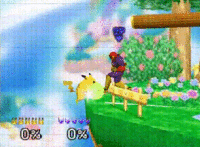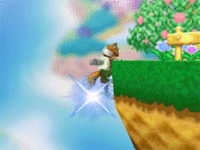Planking
- "Plank" redirects here. For the tournament director, see Smasher:Plank.

Planking is a form of camping that abuses the invincibility of stage ledges. Named after a Meta Knight player from Maryland called Plank who was known for "planking" the edge, planking refers to repeatedly dropping off the ledge and grabbing it again, gaining protection given from the invincibility frames obtained from grabbing the ledge. Planking is possible in three of the Smash Bros. games, 64, Melee, and Brawl, but it is especially difficult to edgeguard against in Brawl, due to larger ledge sweetspots, a larger pool of characters that can effectively perform planking, and that Smash 64 and Melee lack high-tiered characters that can plank well. Planking is also harder in 64 because you lose ledge invincibility if you let go of the ledge
Planking is noteworthy as a tactic due to how difficult it can be to intercept; attempts to attack the planker are typically met with aerial attacks, that can set up a gimp KO, while other methods, such as projectiles, are either too inaccurate or too weak to effectively break the planking. Additionally, all characters can plank to some extent in Brawl, though having access to a fast attack that produces a large hitbox to protect the character, and being able to regrab the ledge quickly, are attributes that strengthen a character's planking ability. Meta Knight is the most notorious example of a character highly effective at planking, though Mr. Game & Watch and Pit are also examples of characters notorious for highly effective planking; Melee and Smash 64 are notable for lacking many characters that have this property.
Planking is a controversial tactic in Brawl, due to the risk/reward factor typically being heavily skewed in the planker's favor, and the general consensus that heavy utilisation of planking is not enjoyable to fight against nor watch. Meta Knight's extreme planking ability, however, was among the primary reasons why planking was limited, as many players generally thought the tactic was unbeatable. In tournaments, excessive planking is usually limited through a ledge grab rule, though the rule itself doesn't prevent planking entirely (as a player can still plank and not reach the ledge grab limit); a blanket rule in the Brawl ruleset that states "Stalling is banned" can also be applied to planking, though such determinations are up to the discretion of the Tournament Organizer.
Planking is effectively impossible to use in a practical manner in Super Smash Bros. 4 due to new ledge grabbing mechanics. Characters only have ledge invincibility on their first ledge grab; regrabbing the ledge without landing on the stage first or before getting flinched by an opponent will result in the player grabbing the ledge with absolutely no invincibility at all, leaving them wide open for a meteor smash or a charged smash that hits ledge-hanging opponents. The introduction of ledge-stealing also weakens planking further, as a player can knock an opponent off the ledge through their ledge invincibility and leave them without their ledge invincibility if they're forced to regrab the ledge. This tactic still has use with Bayonetta, as she can use Witch Twist to grab/regrab the ledge. If the opponent tries to punish her for regrabbing the ledge, she can overshoot the ledge with her up B and Witch Time or even air dodge with Bat-within, making it dangerous to punish her at the ledge.
Counters to planking
Anti planking
A Brawl-specific technique discovered by Logic and put on YouTube by VGBootCamp. Anti-planking is performed by shielding a planker's aerial attack to cause shield stun. During this, the player can SDI off the stage and hit the planking character, taking advantage of the aerial attack's ending lag. The timing for performing anti planking varies on the character that is involved, but Meta Knight is the most difficult to perform this on. If performed incorrectly, the player poses the risk of self destructing.
Characters notable for anti planking
- Diddy Kong: After SDI'ing off the ledge, Diddy Kong can buffer a down aerial. Unlike other characters, he can recover with greater ease than others.
- Falco: Falco can use a down air, though, it cannot be buffered, and is very difficult to recover from.
- Mr. Game & Watch: Mr. Game & Watch can use a down air to either meteor smash or stage spike Meta Knight, but is difficult to recover from.
- Marth: Marth can use down air, but it's nearly impossible to recover from, due to its heavy endlag.
Ledge grab limit
As excessive planking is generally considered degenerate to Brawl competitive play, the majority of tournaments have a ledge grab limit. This is enforced using the end of match statistics, where it says on the results screen how many times a player has grabbed the ledge. If a match ends in time out, and a player has grabbed over the amount of times allowed (usually in between 30 and 50 grabs, with Meta Knight usually being allowed significantly fewer ledge grabs), they are disqualified and the opponent wins the game, regardless of remaining stock and damage count. However, if both players exceed the ledge grabbing limit, the normal time out rules apply.
Whether or not ledge grab limits should continue to be implemented is controversial, particularly for Meta Knight banned tournaments. An argument against the ledge grab limit is that it's a surgical and arbitrary rule, that doesn't fix the problem, and can unfairly punish a player who exceeded the ledge grab limit from being kept offstage often by the opponent, rather than planking with the intention of timing out. Another argument against the ledge grab limit is that planking is a part of the game, that is fully beatable if dealt with properly, and arbitrarily buffs characters that are poor at fighting on the ledge, such as Falco. One more argument is that Meta Knight is the only character whose planking is broken, and with him banned, a ledge grab limit becomes unnecessary and outdated. The ledge grab limit controversy exploded after WHOBO 3, a national tournament that didn't implement a ledge grab limit on characters other than Meta Knight, after Will defeated Rich Brown deep in the tournament through abusing the lack of a ledge grab limit[1], winning despite him having a large disadvantage in terms of the character matchup. While it has been argued that Rich Brown didn't combat Will's planking properly, the match is used for reference as proof that characters other than Meta Knight are capable of heavy, unreasonably hard to beat planking, and to show the degenerate effects unrestricted planking has on a match. The fallout after the tournament strengthened the support for ledge grab limits, and ledge grab limits have become a universal aspect of US rulesets since.
Air Time rule
An alternative anti-planking rule to ledge grab limits, is the air time rule, a rule primarily used in Japan and Mexico, that also heavily limits air camping. With the air time rule, if a match goes to time, the end of match statistics are looked at, and the player who spent more time in the air loses, regardless of remaining stock and damage percent. This rule, however, is heavily criticised, and rarely implemented instead of a ledge grab limit in other areas of North America and in Europe. The main criticism of the rule is that it unfairly penalises frequently airborne characters such as Kirby or Wario, while buffing ground-based characters such as Snake and Diddy Kong. Other criticisms of the rule include the fact it overrides the game's time-out rule of rewarding the victory to the player with more stocks, it limiting air camping and other such tactics the player has to be airborne for, despite such tactics not being considered degenerate/broken, and the possibility for the rule to reward victory to a player that was soundly outplayed for something that isn't indicative of how each player performed.
